Comprehensive Analysis: Demand and Supply of Nurses in NSW, Australia
VerifiedAdded on 2021/06/15
|8
|1557
|44
Report
AI Summary
This report provides an analysis of the demand and supply dynamics of nurses in New South Wales (NSW), Australia, highlighting a critical shortage. The report examines the factors influencing the increasing demand for nurses, such as an aging population, rising chronic diseases, and increased population and income levels. Concurrently, it investigates the factors contributing to a decreasing supply, including a decline in nursing student enrollment, an aging workforce, and workplace and retention issues. The analysis includes graphical representations of the demand and supply curves and discusses the implications of the imbalance, such as rising healthcare costs. The report concludes with recommendations for addressing the shortage, including increased government funding for nursing education, support for student internships, and measures to improve workplace conditions and nurse retention. The report references several articles to support its findings.
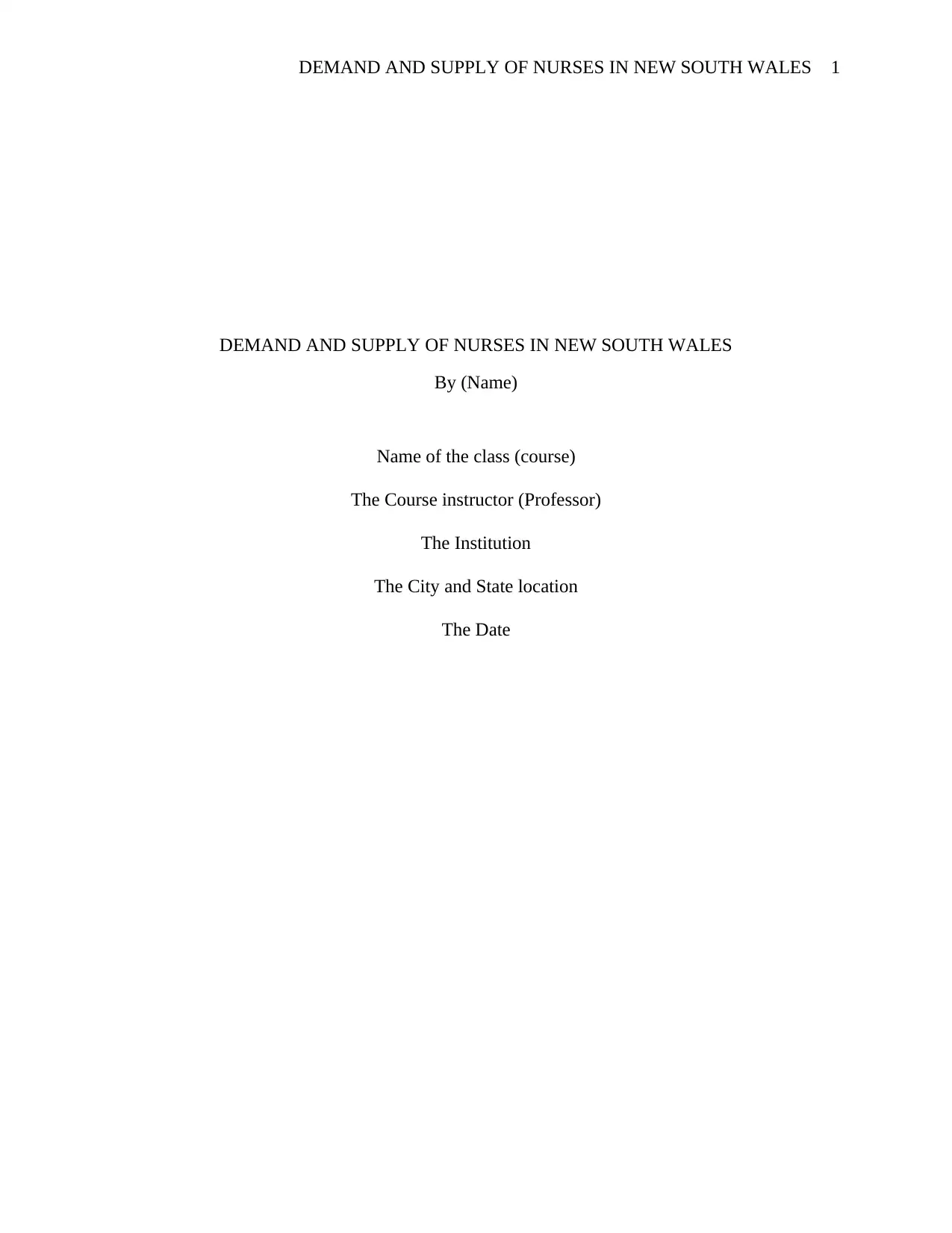
DEMAND AND SUPPLY OF NURSES IN NEW SOUTH WALES 1
DEMAND AND SUPPLY OF NURSES IN NEW SOUTH WALES
By (Name)
Name of the class (course)
The Course instructor (Professor)
The Institution
The City and State location
The Date
DEMAND AND SUPPLY OF NURSES IN NEW SOUTH WALES
By (Name)
Name of the class (course)
The Course instructor (Professor)
The Institution
The City and State location
The Date
Paraphrase This Document
Need a fresh take? Get an instant paraphrase of this document with our AI Paraphraser
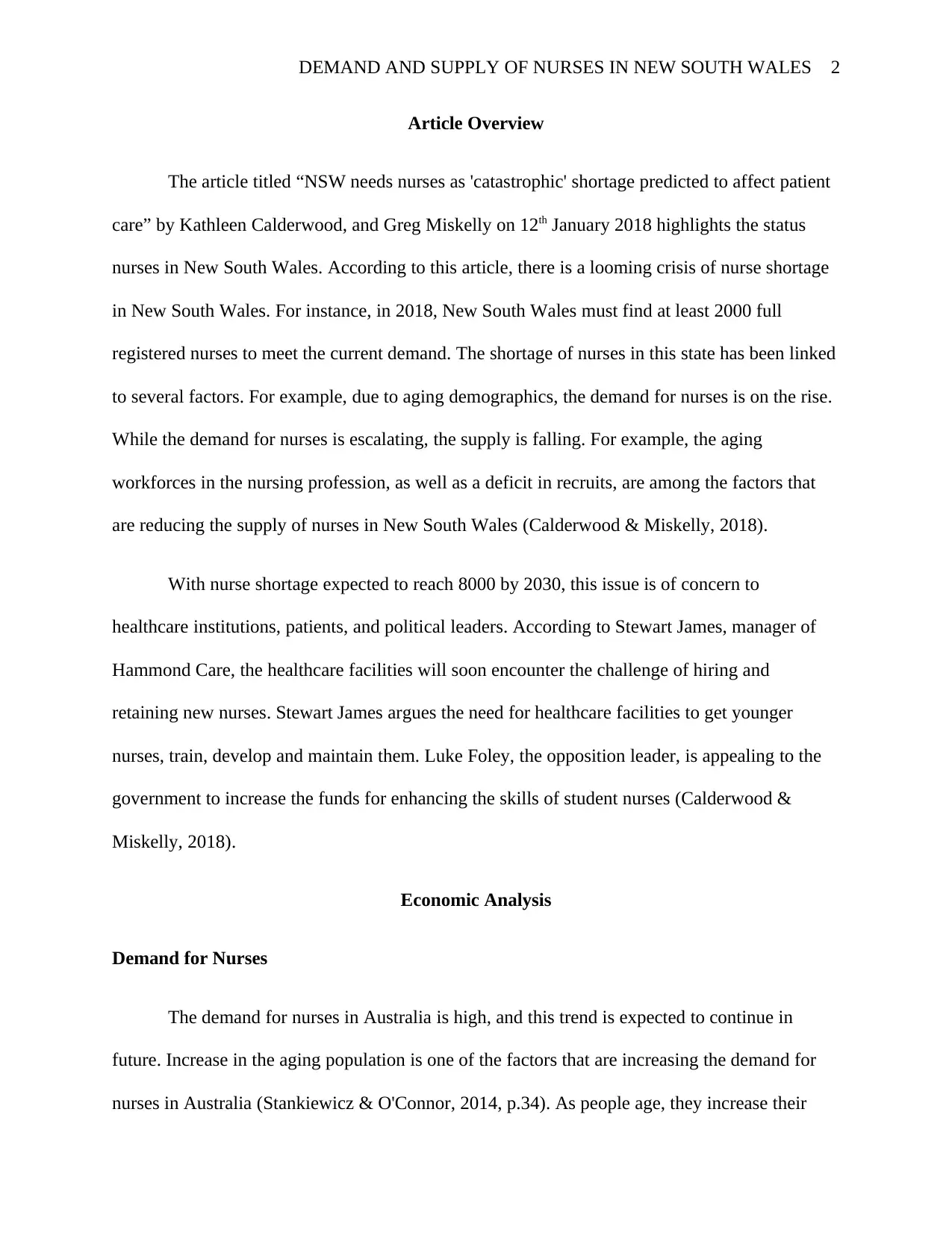
DEMAND AND SUPPLY OF NURSES IN NEW SOUTH WALES 2
Article Overview
The article titled “NSW needs nurses as 'catastrophic' shortage predicted to affect patient
care” by Kathleen Calderwood, and Greg Miskelly on 12th January 2018 highlights the status
nurses in New South Wales. According to this article, there is a looming crisis of nurse shortage
in New South Wales. For instance, in 2018, New South Wales must find at least 2000 full
registered nurses to meet the current demand. The shortage of nurses in this state has been linked
to several factors. For example, due to aging demographics, the demand for nurses is on the rise.
While the demand for nurses is escalating, the supply is falling. For example, the aging
workforces in the nursing profession, as well as a deficit in recruits, are among the factors that
are reducing the supply of nurses in New South Wales (Calderwood & Miskelly, 2018).
With nurse shortage expected to reach 8000 by 2030, this issue is of concern to
healthcare institutions, patients, and political leaders. According to Stewart James, manager of
Hammond Care, the healthcare facilities will soon encounter the challenge of hiring and
retaining new nurses. Stewart James argues the need for healthcare facilities to get younger
nurses, train, develop and maintain them. Luke Foley, the opposition leader, is appealing to the
government to increase the funds for enhancing the skills of student nurses (Calderwood &
Miskelly, 2018).
Economic Analysis
Demand for Nurses
The demand for nurses in Australia is high, and this trend is expected to continue in
future. Increase in the aging population is one of the factors that are increasing the demand for
nurses in Australia (Stankiewicz & O'Connor, 2014, p.34). As people age, they increase their
Article Overview
The article titled “NSW needs nurses as 'catastrophic' shortage predicted to affect patient
care” by Kathleen Calderwood, and Greg Miskelly on 12th January 2018 highlights the status
nurses in New South Wales. According to this article, there is a looming crisis of nurse shortage
in New South Wales. For instance, in 2018, New South Wales must find at least 2000 full
registered nurses to meet the current demand. The shortage of nurses in this state has been linked
to several factors. For example, due to aging demographics, the demand for nurses is on the rise.
While the demand for nurses is escalating, the supply is falling. For example, the aging
workforces in the nursing profession, as well as a deficit in recruits, are among the factors that
are reducing the supply of nurses in New South Wales (Calderwood & Miskelly, 2018).
With nurse shortage expected to reach 8000 by 2030, this issue is of concern to
healthcare institutions, patients, and political leaders. According to Stewart James, manager of
Hammond Care, the healthcare facilities will soon encounter the challenge of hiring and
retaining new nurses. Stewart James argues the need for healthcare facilities to get younger
nurses, train, develop and maintain them. Luke Foley, the opposition leader, is appealing to the
government to increase the funds for enhancing the skills of student nurses (Calderwood &
Miskelly, 2018).
Economic Analysis
Demand for Nurses
The demand for nurses in Australia is high, and this trend is expected to continue in
future. Increase in the aging population is one of the factors that are increasing the demand for
nurses in Australia (Stankiewicz & O'Connor, 2014, p.34). As people age, they increase their
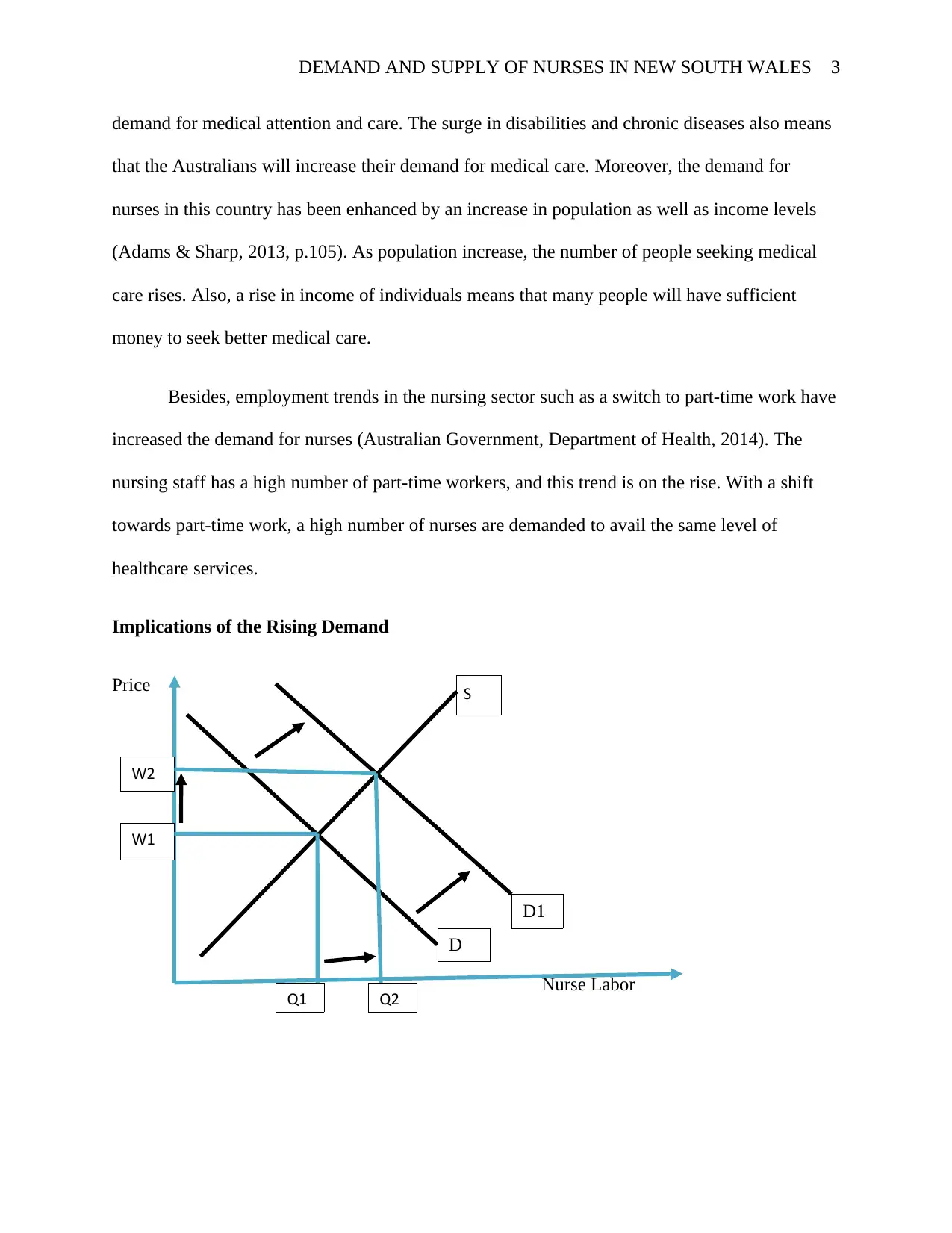
DEMAND AND SUPPLY OF NURSES IN NEW SOUTH WALES 3
demand for medical attention and care. The surge in disabilities and chronic diseases also means
that the Australians will increase their demand for medical care. Moreover, the demand for
nurses in this country has been enhanced by an increase in population as well as income levels
(Adams & Sharp, 2013, p.105). As population increase, the number of people seeking medical
care rises. Also, a rise in income of individuals means that many people will have sufficient
money to seek better medical care.
Besides, employment trends in the nursing sector such as a switch to part-time work have
increased the demand for nurses (Australian Government, Department of Health, 2014). The
nursing staff has a high number of part-time workers, and this trend is on the rise. With a shift
towards part-time work, a high number of nurses are demanded to avail the same level of
healthcare services.
Implications of the Rising Demand
Price
Nurse Labor
S
W2
W1
Q2Q1
D1
D
demand for medical attention and care. The surge in disabilities and chronic diseases also means
that the Australians will increase their demand for medical care. Moreover, the demand for
nurses in this country has been enhanced by an increase in population as well as income levels
(Adams & Sharp, 2013, p.105). As population increase, the number of people seeking medical
care rises. Also, a rise in income of individuals means that many people will have sufficient
money to seek better medical care.
Besides, employment trends in the nursing sector such as a switch to part-time work have
increased the demand for nurses (Australian Government, Department of Health, 2014). The
nursing staff has a high number of part-time workers, and this trend is on the rise. With a shift
towards part-time work, a high number of nurses are demanded to avail the same level of
healthcare services.
Implications of the Rising Demand
Price
Nurse Labor
S
W2
W1
Q2Q1
D1
D
⊘ This is a preview!⊘
Do you want full access?
Subscribe today to unlock all pages.

Trusted by 1+ million students worldwide
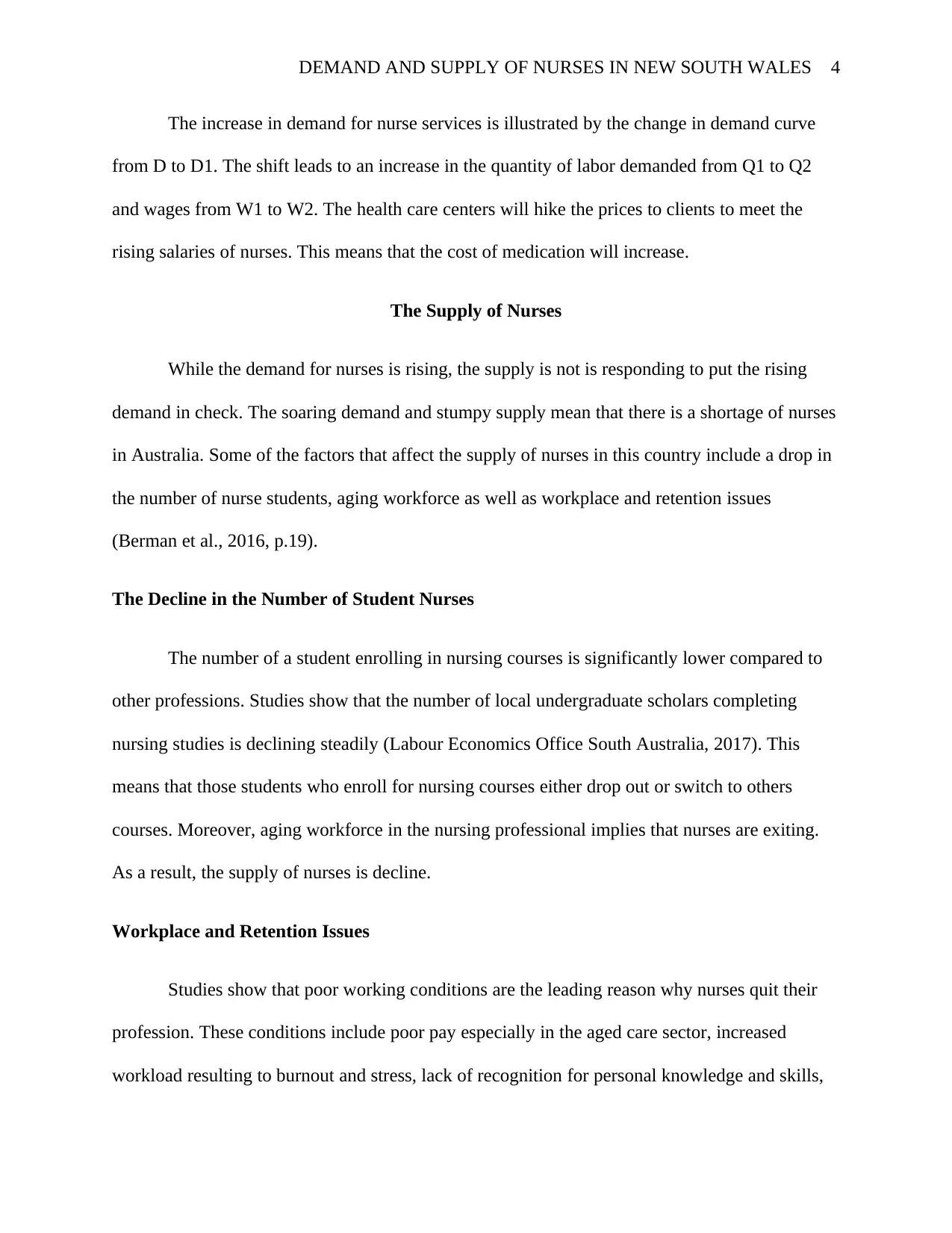
DEMAND AND SUPPLY OF NURSES IN NEW SOUTH WALES 4
The increase in demand for nurse services is illustrated by the change in demand curve
from D to D1. The shift leads to an increase in the quantity of labor demanded from Q1 to Q2
and wages from W1 to W2. The health care centers will hike the prices to clients to meet the
rising salaries of nurses. This means that the cost of medication will increase.
The Supply of Nurses
While the demand for nurses is rising, the supply is not is responding to put the rising
demand in check. The soaring demand and stumpy supply mean that there is a shortage of nurses
in Australia. Some of the factors that affect the supply of nurses in this country include a drop in
the number of nurse students, aging workforce as well as workplace and retention issues
(Berman et al., 2016, p.19).
The Decline in the Number of Student Nurses
The number of a student enrolling in nursing courses is significantly lower compared to
other professions. Studies show that the number of local undergraduate scholars completing
nursing studies is declining steadily (Labour Economics Office South Australia, 2017). This
means that those students who enroll for nursing courses either drop out or switch to others
courses. Moreover, aging workforce in the nursing professional implies that nurses are exiting.
As a result, the supply of nurses is decline.
Workplace and Retention Issues
Studies show that poor working conditions are the leading reason why nurses quit their
profession. These conditions include poor pay especially in the aged care sector, increased
workload resulting to burnout and stress, lack of recognition for personal knowledge and skills,
The increase in demand for nurse services is illustrated by the change in demand curve
from D to D1. The shift leads to an increase in the quantity of labor demanded from Q1 to Q2
and wages from W1 to W2. The health care centers will hike the prices to clients to meet the
rising salaries of nurses. This means that the cost of medication will increase.
The Supply of Nurses
While the demand for nurses is rising, the supply is not is responding to put the rising
demand in check. The soaring demand and stumpy supply mean that there is a shortage of nurses
in Australia. Some of the factors that affect the supply of nurses in this country include a drop in
the number of nurse students, aging workforce as well as workplace and retention issues
(Berman et al., 2016, p.19).
The Decline in the Number of Student Nurses
The number of a student enrolling in nursing courses is significantly lower compared to
other professions. Studies show that the number of local undergraduate scholars completing
nursing studies is declining steadily (Labour Economics Office South Australia, 2017). This
means that those students who enroll for nursing courses either drop out or switch to others
courses. Moreover, aging workforce in the nursing professional implies that nurses are exiting.
As a result, the supply of nurses is decline.
Workplace and Retention Issues
Studies show that poor working conditions are the leading reason why nurses quit their
profession. These conditions include poor pay especially in the aged care sector, increased
workload resulting to burnout and stress, lack of recognition for personal knowledge and skills,
Paraphrase This Document
Need a fresh take? Get an instant paraphrase of this document with our AI Paraphraser
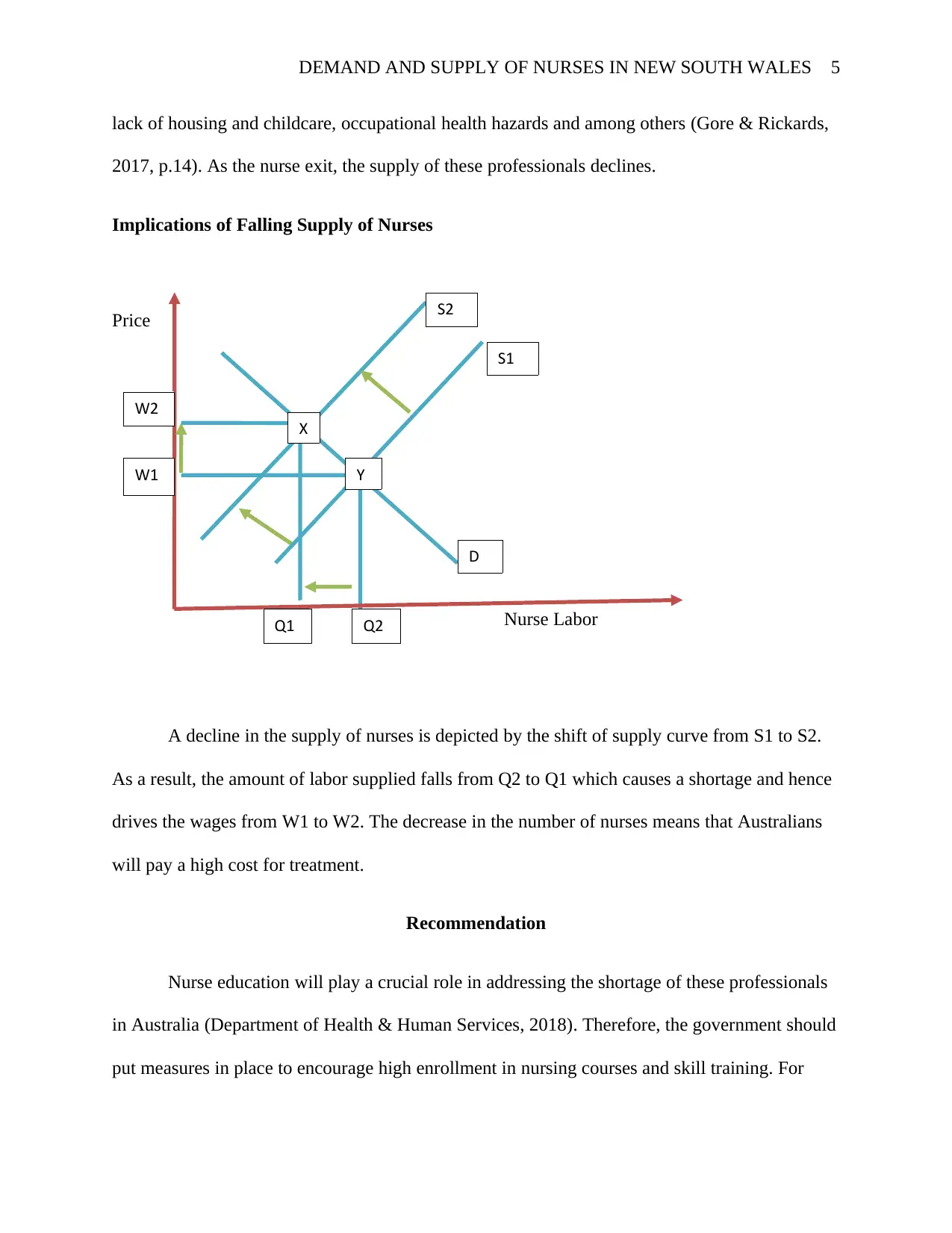
DEMAND AND SUPPLY OF NURSES IN NEW SOUTH WALES 5
lack of housing and childcare, occupational health hazards and among others (Gore & Rickards,
2017, p.14). As the nurse exit, the supply of these professionals declines.
Implications of Falling Supply of Nurses
Price
Nurse Labor
A decline in the supply of nurses is depicted by the shift of supply curve from S1 to S2.
As a result, the amount of labor supplied falls from Q2 to Q1 which causes a shortage and hence
drives the wages from W1 to W2. The decrease in the number of nurses means that Australians
will pay a high cost for treatment.
Recommendation
Nurse education will play a crucial role in addressing the shortage of these professionals
in Australia (Department of Health & Human Services, 2018). Therefore, the government should
put measures in place to encourage high enrollment in nursing courses and skill training. For
W2
W1
S1
D
Q2Q1
Y
X
S2
lack of housing and childcare, occupational health hazards and among others (Gore & Rickards,
2017, p.14). As the nurse exit, the supply of these professionals declines.
Implications of Falling Supply of Nurses
Price
Nurse Labor
A decline in the supply of nurses is depicted by the shift of supply curve from S1 to S2.
As a result, the amount of labor supplied falls from Q2 to Q1 which causes a shortage and hence
drives the wages from W1 to W2. The decrease in the number of nurses means that Australians
will pay a high cost for treatment.
Recommendation
Nurse education will play a crucial role in addressing the shortage of these professionals
in Australia (Department of Health & Human Services, 2018). Therefore, the government should
put measures in place to encourage high enrollment in nursing courses and skill training. For
W2
W1
S1
D
Q2Q1
Y
X
S2
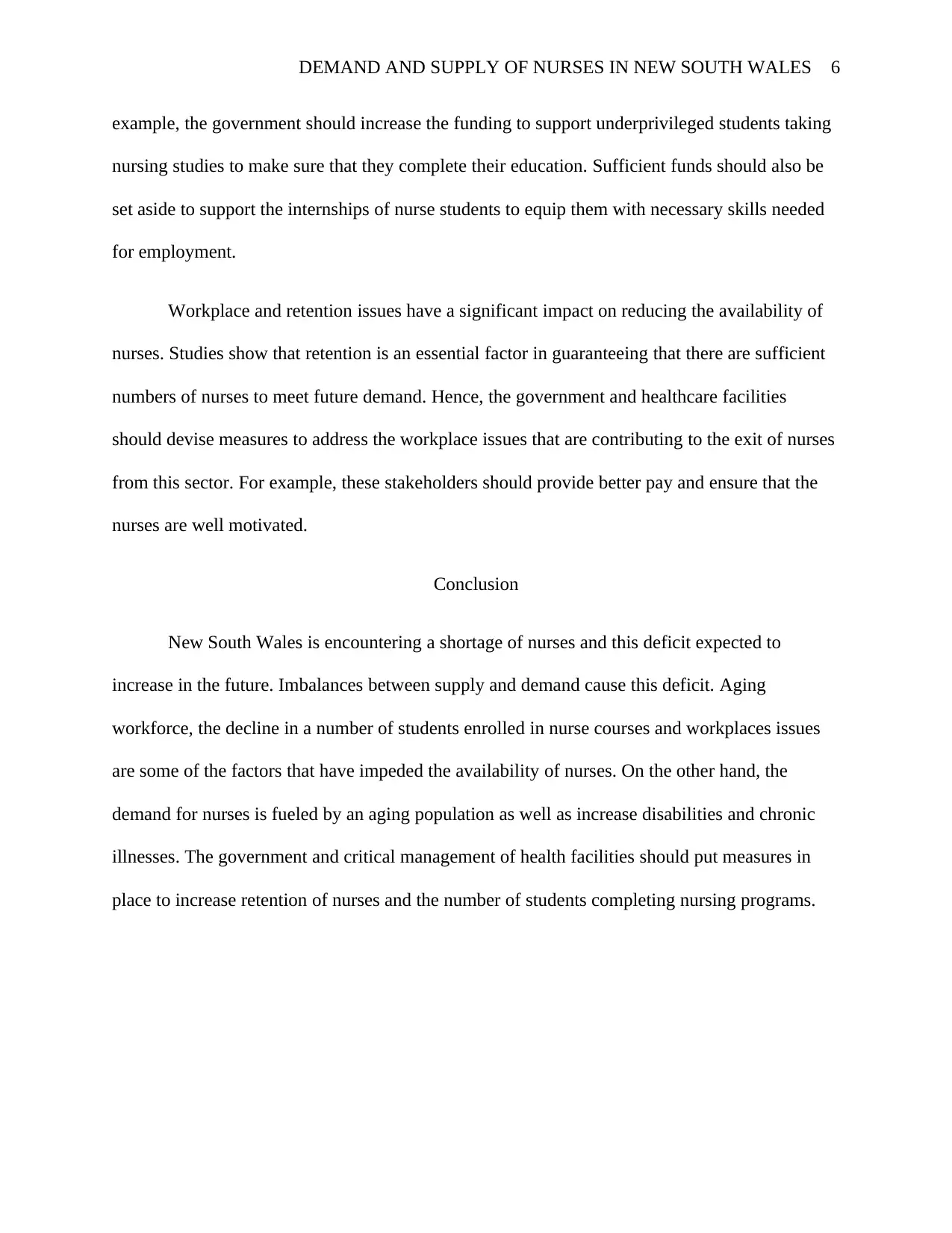
DEMAND AND SUPPLY OF NURSES IN NEW SOUTH WALES 6
example, the government should increase the funding to support underprivileged students taking
nursing studies to make sure that they complete their education. Sufficient funds should also be
set aside to support the internships of nurse students to equip them with necessary skills needed
for employment.
Workplace and retention issues have a significant impact on reducing the availability of
nurses. Studies show that retention is an essential factor in guaranteeing that there are sufficient
numbers of nurses to meet future demand. Hence, the government and healthcare facilities
should devise measures to address the workplace issues that are contributing to the exit of nurses
from this sector. For example, these stakeholders should provide better pay and ensure that the
nurses are well motivated.
Conclusion
New South Wales is encountering a shortage of nurses and this deficit expected to
increase in the future. Imbalances between supply and demand cause this deficit. Aging
workforce, the decline in a number of students enrolled in nurse courses and workplaces issues
are some of the factors that have impeded the availability of nurses. On the other hand, the
demand for nurses is fueled by an aging population as well as increase disabilities and chronic
illnesses. The government and critical management of health facilities should put measures in
place to increase retention of nurses and the number of students completing nursing programs.
example, the government should increase the funding to support underprivileged students taking
nursing studies to make sure that they complete their education. Sufficient funds should also be
set aside to support the internships of nurse students to equip them with necessary skills needed
for employment.
Workplace and retention issues have a significant impact on reducing the availability of
nurses. Studies show that retention is an essential factor in guaranteeing that there are sufficient
numbers of nurses to meet future demand. Hence, the government and healthcare facilities
should devise measures to address the workplace issues that are contributing to the exit of nurses
from this sector. For example, these stakeholders should provide better pay and ensure that the
nurses are well motivated.
Conclusion
New South Wales is encountering a shortage of nurses and this deficit expected to
increase in the future. Imbalances between supply and demand cause this deficit. Aging
workforce, the decline in a number of students enrolled in nurse courses and workplaces issues
are some of the factors that have impeded the availability of nurses. On the other hand, the
demand for nurses is fueled by an aging population as well as increase disabilities and chronic
illnesses. The government and critical management of health facilities should put measures in
place to increase retention of nurses and the number of students completing nursing programs.
⊘ This is a preview!⊘
Do you want full access?
Subscribe today to unlock all pages.

Trusted by 1+ million students worldwide
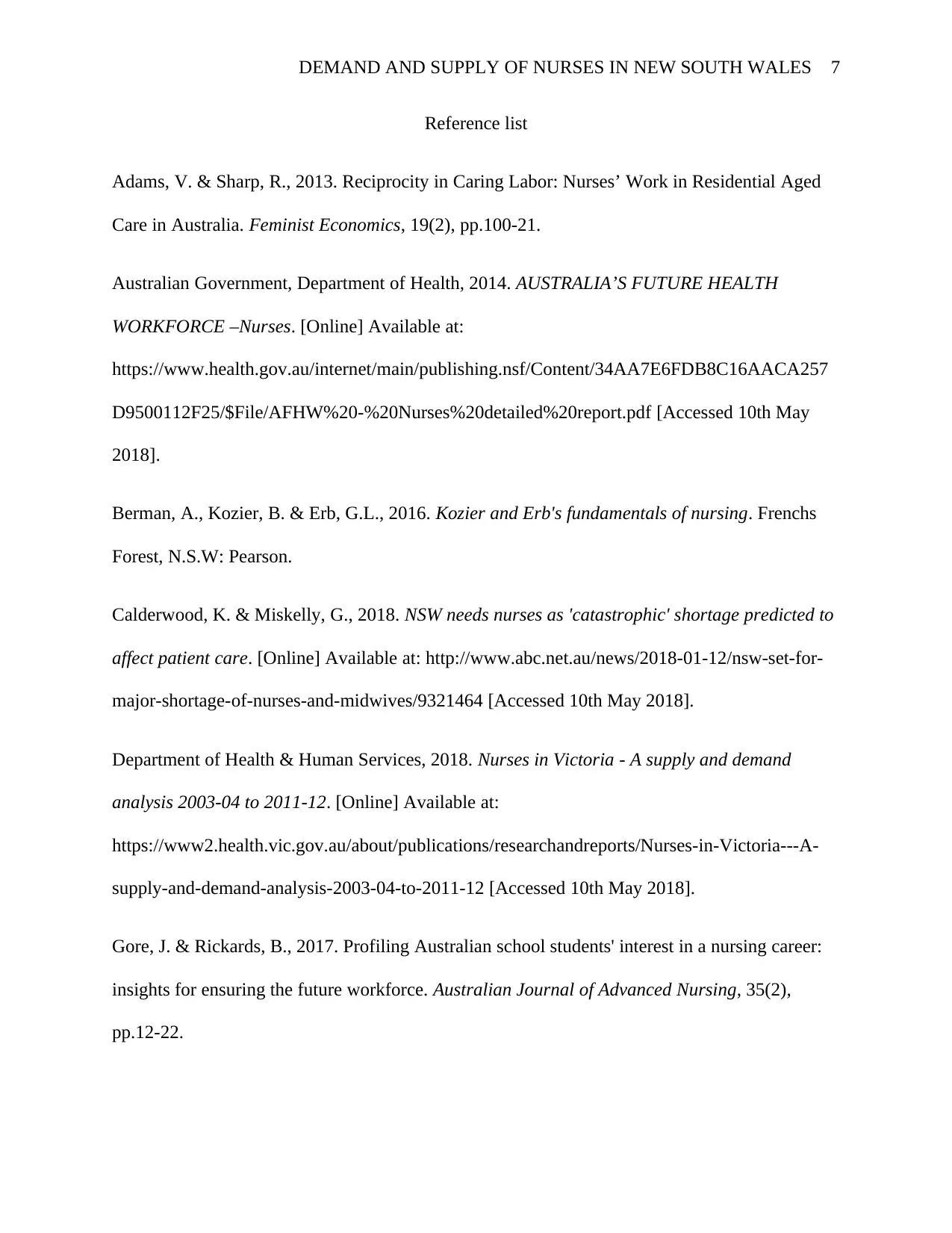
DEMAND AND SUPPLY OF NURSES IN NEW SOUTH WALES 7
Reference list
Adams, V. & Sharp, R., 2013. Reciprocity in Caring Labor: Nurses’ Work in Residential Aged
Care in Australia. Feminist Economics, 19(2), pp.100-21.
Australian Government, Department of Health, 2014. AUSTRALIA’S FUTURE HEALTH
WORKFORCE –Nurses. [Online] Available at:
https://www.health.gov.au/internet/main/publishing.nsf/Content/34AA7E6FDB8C16AACA257
D9500112F25/$File/AFHW%20-%20Nurses%20detailed%20report.pdf [Accessed 10th May
2018].
Berman, A., Kozier, B. & Erb, G.L., 2016. Kozier and Erb's fundamentals of nursing. Frenchs
Forest, N.S.W: Pearson.
Calderwood, K. & Miskelly, G., 2018. NSW needs nurses as 'catastrophic' shortage predicted to
affect patient care. [Online] Available at: http://www.abc.net.au/news/2018-01-12/nsw-set-for-
major-shortage-of-nurses-and-midwives/9321464 [Accessed 10th May 2018].
Department of Health & Human Services, 2018. Nurses in Victoria - A supply and demand
analysis 2003-04 to 2011-12. [Online] Available at:
https://www2.health.vic.gov.au/about/publications/researchandreports/Nurses-in-Victoria---A-
supply-and-demand-analysis-2003-04-to-2011-12 [Accessed 10th May 2018].
Gore, J. & Rickards, B., 2017. Profiling Australian school students' interest in a nursing career:
insights for ensuring the future workforce. Australian Journal of Advanced Nursing, 35(2),
pp.12-22.
Reference list
Adams, V. & Sharp, R., 2013. Reciprocity in Caring Labor: Nurses’ Work in Residential Aged
Care in Australia. Feminist Economics, 19(2), pp.100-21.
Australian Government, Department of Health, 2014. AUSTRALIA’S FUTURE HEALTH
WORKFORCE –Nurses. [Online] Available at:
https://www.health.gov.au/internet/main/publishing.nsf/Content/34AA7E6FDB8C16AACA257
D9500112F25/$File/AFHW%20-%20Nurses%20detailed%20report.pdf [Accessed 10th May
2018].
Berman, A., Kozier, B. & Erb, G.L., 2016. Kozier and Erb's fundamentals of nursing. Frenchs
Forest, N.S.W: Pearson.
Calderwood, K. & Miskelly, G., 2018. NSW needs nurses as 'catastrophic' shortage predicted to
affect patient care. [Online] Available at: http://www.abc.net.au/news/2018-01-12/nsw-set-for-
major-shortage-of-nurses-and-midwives/9321464 [Accessed 10th May 2018].
Department of Health & Human Services, 2018. Nurses in Victoria - A supply and demand
analysis 2003-04 to 2011-12. [Online] Available at:
https://www2.health.vic.gov.au/about/publications/researchandreports/Nurses-in-Victoria---A-
supply-and-demand-analysis-2003-04-to-2011-12 [Accessed 10th May 2018].
Gore, J. & Rickards, B., 2017. Profiling Australian school students' interest in a nursing career:
insights for ensuring the future workforce. Australian Journal of Advanced Nursing, 35(2),
pp.12-22.
Paraphrase This Document
Need a fresh take? Get an instant paraphrase of this document with our AI Paraphraser
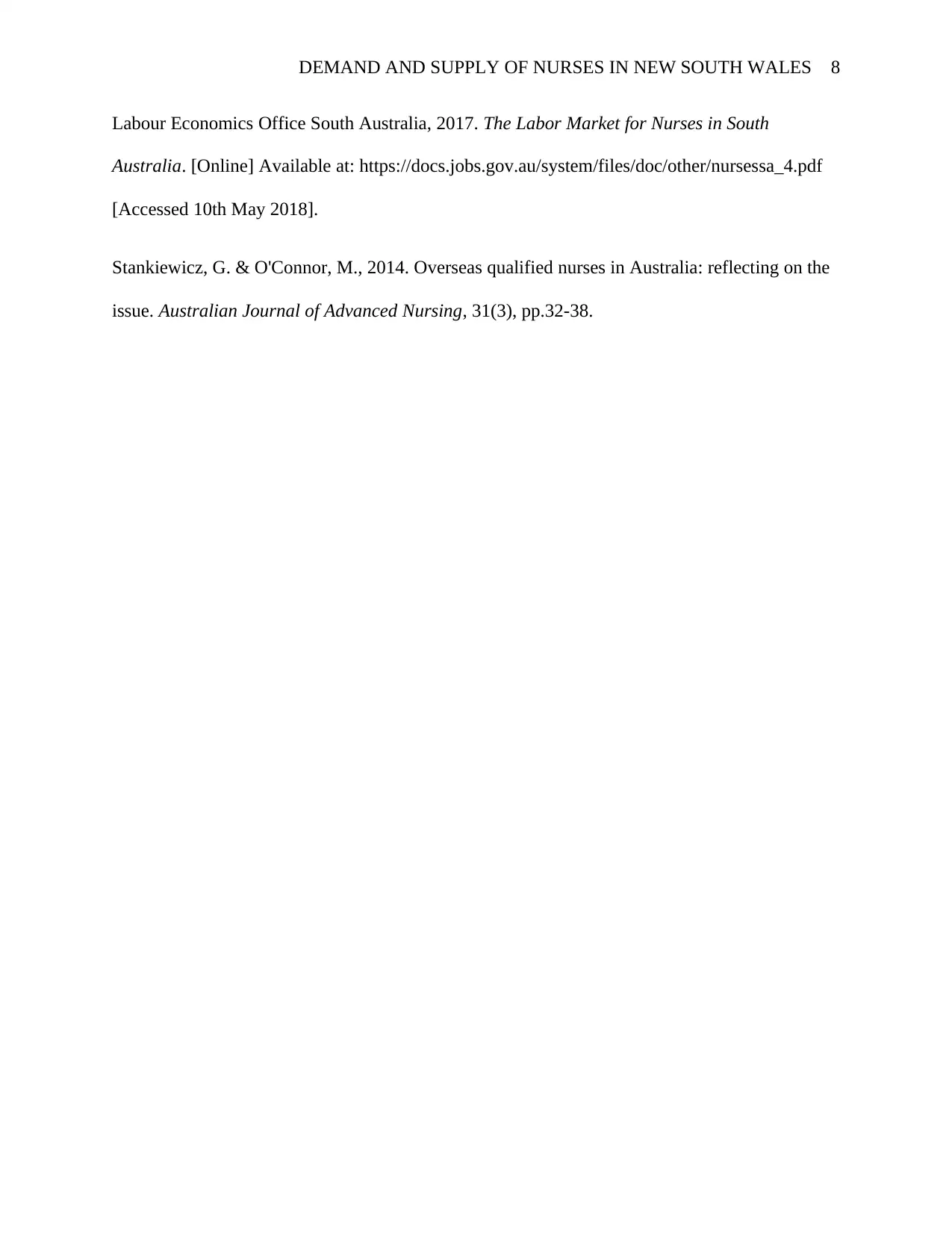
DEMAND AND SUPPLY OF NURSES IN NEW SOUTH WALES 8
Labour Economics Office South Australia, 2017. The Labor Market for Nurses in South
Australia. [Online] Available at: https://docs.jobs.gov.au/system/files/doc/other/nursessa_4.pdf
[Accessed 10th May 2018].
Stankiewicz, G. & O'Connor, M., 2014. Overseas qualified nurses in Australia: reflecting on the
issue. Australian Journal of Advanced Nursing, 31(3), pp.32-38.
Labour Economics Office South Australia, 2017. The Labor Market for Nurses in South
Australia. [Online] Available at: https://docs.jobs.gov.au/system/files/doc/other/nursessa_4.pdf
[Accessed 10th May 2018].
Stankiewicz, G. & O'Connor, M., 2014. Overseas qualified nurses in Australia: reflecting on the
issue. Australian Journal of Advanced Nursing, 31(3), pp.32-38.
1 out of 8
Related Documents
Your All-in-One AI-Powered Toolkit for Academic Success.
+13062052269
info@desklib.com
Available 24*7 on WhatsApp / Email
![[object Object]](/_next/static/media/star-bottom.7253800d.svg)
Unlock your academic potential
Copyright © 2020–2025 A2Z Services. All Rights Reserved. Developed and managed by ZUCOL.





